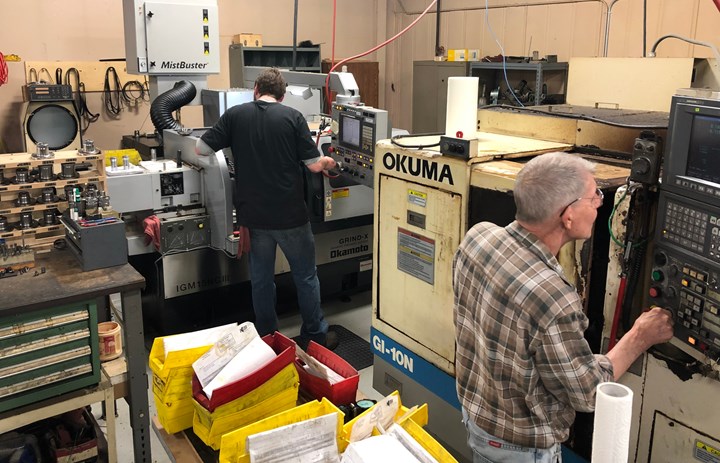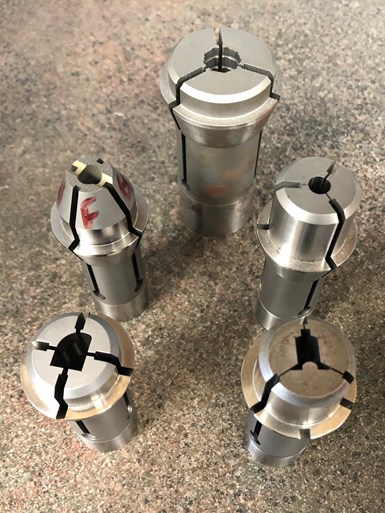Enterprise resource planning (ERP) software, in general terms, helps an organization to manage its overall operations by integrating all aspects of the business, from front office applications such as accounting, estimating and reporting, to manufacturing requirements such as equipment scheduling, data management and product delivery. It automates much of what has traditionally been done on paper, allowing shops to become more efficient and reduce user error.
KEB Industries Inc., a family-owned and operated supplier of precision tooling for Swiss CNC machines, recently implemented such a system to alleviate the limitations of its existing off-the-shelf accounting package. The new system has far exceeded the company’s expectations, providing additional functionality that is having a large impact on the company’s bottom line.
Workholding Production
KEB opened its operations in 2003 after acquiring the intellectual property of Maswerks and the necessary equipment to continue the production of its line of collets and guide bushings. The company has continued to slowly grow, acquiring additional machines including a traditional lathe cell, Haas and Okuma milling machines and grinders from Usach, Okamoto and Okuma. It’s this grinding department that Bradley Butler, company owner, feels has helped KEB leave its biggest mark on the industry.

KEB uses grinding machines set up with multiple spindle configurations to meet the needs for the varying diameter sizes produced.
“ID grinding is kind of like a black art,” Mr. Butler says. “In general manufacturing, you usually think of grinding larger diameters. But we’re dealing with diameters all the way down to 0.028 inch and sizes only as large as an inch and a half.” Different machines on the floor run a variety of RPMs. The Usachs, with high frequency, high-rpm spindles, are set up to run only small diameters. The Okamoto has a 60,000-rpm spindle for small to intermediate diameters, and the heavy Okuma machine, with a more traditional 40,000-rpm, belt-driven spindle, designed to remove material faster, is used to grind the biggest diameters.
Standard KEB collets are machined to a tolerance of 0.0005 inch (or better) total indicator reading (TIR). Standard KEB guide bushings are precision ground to a coaxiality of 0.0002 inch or better. Coaxiality is a more rigorous measurement than TIR, testing the concentricity of multiple ID and OD points simultaneously and their interrelationship with each other. Mr. Butler says this precision sets KEB’s products apart from the competition.
“Concentrating on precision, we’re able to take the difficult custom jobs,” he says. Many U.S. medical manufacturers are using high precision custom workholding for both implants and instrumentation, and it is common in aerospace applications as well. But KEB also reaches other markets. “A lot of companies need a half-inch-diameter collet, for instance, for lights-out production for automotive or other parts. The product is suitable for all sectors of manufacturing, whether aerospace, medical, industrial, marine, tooling manufacturing, and so on,” Mr. Butler says.

This small sampling of the thousands of parts KEB produces shows a variety of profile shapes along with a serrated gripper collet (top) designed for heavy machining operations.
The company produces all different shapes and profiles, including octagonal, oval, off center and extrusion shapes. Some customers require the ID to be ground, and then they cut profiles into an extension on the nose of the collet. Mr. Butler says, “Back when Swiss manufacturing first started taking off, round diameters were the norm. But people are smart; they figured out ways to better utilize the machines and are coming up with new designs all the time.”
Shop Control
As an organizational tool to oversee operations, KEB had implemented a standard, off-the-shelf shop control software package. For years the software served its purpose—it was functional on the accounting side. But it was fairly limited on the shop side. A couple of years back, Mr. Butler felt the company had crossed a threshold where the software was no longer sufficient. The processing and the tracking of orders was difficult, and it didn’t have the capability to sort and plan based on product groups.
The company needed a system that was more streamlined for its operations. KEB typically ships products within seven days of the order, so everything in the production process needs to run efficiently. “We do so much custom work, and standard, off-the-shelf systems don’t handle one-off products very well,” Mr. Butler says. “We needed a system that could adapt to allow us to take all of these custom parts that are due in a couple of days and pull them together where we can input the routers and get everything scheduled and tracked seamlessly.”
The company had been exhibiting at each Precision Machining Technology Show (PMTS) since it started operations. At one of those early editions, KEB happened to land booth space next to Henning Industrial Software Inc., a software developer specializing in manufacturing and accounting solutions. The two companies remained next to each other for several subsequent shows, and typical of the networking opportunities that take place at PMTS, personnel from the two companies built a friendship and got to know each other’s businesses. “As we grew and started to look into upgrading our software, it was logical to call Henning first because we already had that relationship with them, we had been introduced to the capabilities of their systems, and we knew quite a bit about the software before we were even ready for it,” Mr. Butler says.
Implementation and Use
In 2018, during the first year of using Henning’s ERP software, KEB focused on integration of Visual Books—the accounting and office modules. Mr. Butler wanted the front office to gain a full understanding of the functionality first before moving it out to the shop floor.
The initial setup of the software was vital because it laid the groundwork for all subsequent entries. KEB has a massive database of thousands of part numbers. Henning sent in an expert on the software who spent days with the company helping to configure the system and make sure personnel were comfortable using it. “Henning is really good at customer service,” Mr. Butler says. “They don't just implement the system; they teach you how to best utilize it. That's important.”
Visual EstiTrack, the ERP shop management system that encompasses Visual Books, integrates estimating, sales, shop orders, time collection, job costing, visual scheduling, inventory management, purchasing, receiving, shipping and invoicing. When an order comes in to KEB, it is entered into the system in the front office. From there, it is assigned a router based on the product type and its specifications. A material check is then initiated to confirm availability of the necessary material for production, at which point the job is scheduled based on machine availability and delivery requirements.

The guide bushings, which require high precision, include carbide inserts, which present additional challenges for grinding.
“As the company was growing, we were starting to experience issues keeping control of what was coming down the pipeline and scheduling jobs efficiently,” Mr. Butler says. The scheduling board in the Henning software lays out the pertinent information so it’s more trackable. “Now we can easily see if we have several jobs of like diameter and go ahead and set them up on one machine and minimize our time in switching grinding wheels and changing tools over.” Because almost every part requires more than one machine, the system regularly updates the schedule as the part is passed down the line. The scheduling board displays each operation, from beginning to end—machine, clean, preserve, pack and ship.
Now everyone at KEB uses the ERP software in some form, but according to Mr. Butler, the company is only at the tip of the iceberg for taking full advantage of the shopfloor capabilities. It’s still early in the implementation stage, and it is taking some time to fully populate the database. Each time a part number comes in that is not yet in the system, a router and the appropriate operations, need to be assigned to it.
Mr. Butler says KEB’s method of slow integration, from the office down, has worked well. “Some people may be resistant to the change, but once they see the longer-term benefits, they’re quick to jump aboard.” And the benefits are definitely there. KEB is now able to get more accurate costs on its manufacturing processes. In some cases, this information has indicated the need for price increases, and sometimes they’ve even been able to scale back prices. And the company can more efficiently plan its back-end operations, where intricate details are in play—the most critical part in minimizing setup times. “The ERP package has provided new competitive advantages for KEB,” Mr. Butler says. “By year’s end, we hope to be fully implemented, maximizing the benefits the software brings.”
Related Content
Hack-Proof Your Shop: Production Machining’s 6 Must-Read Cybersecurity Articles
October is cybersecurity awareness month and Production Machining wants to help you make your shop hack-proof.
Read MorePrecision Machining Technology Review: September 2024
Production Machining’s September 2024 technology showcase includes some of the latest technology from Expand Machinery, Paperless Parts, Monaghan Tooling Group, Walter USA and more.
Read MoreProShop Provides ERP Technology to Purdue Engineering School
The ProShop Digital Ecosystem will be used as the inventory management and ERP system at Purdue University’s Industrial Engineering School.
Read MoreERP Software Enables Manufacturers to Maximize Operational Efficiencies
PMTS 2023: JobBoss2 from ECI Software Solutions assists manufacturers with decision-making and reveals opportunities for growth and cost savings.
Read MoreRead Next
Profiting with Shop Management Software
Once all employees can see how process changes can benefit them, implementation becomes easier and efficiency soars.
Read MoreFamily Business Finds ERP Software Tailored to its Needs
When Jim Roberts and the rest of the management team at Roberts Automatic Products decided that they had to purchase an ERP software system for their growing company, it was anything but an easy decision.
Read MoreTaking Shop Management Software on the Road
In a fast-moving shop where every minute counts, efficiency of operation is the key to success. Every time someone must leave his or her workcenter to review workorders, check on status or log into a workorder operation, time is wasted.
Read More















.jpg;maxWidth=300;quality=90)







